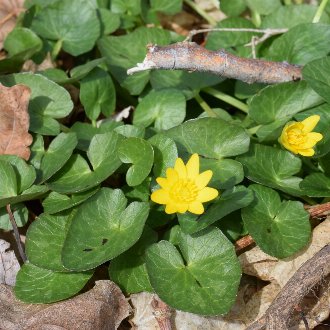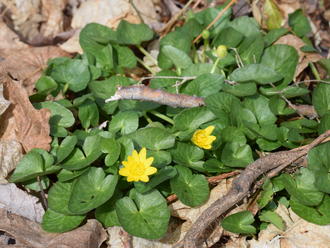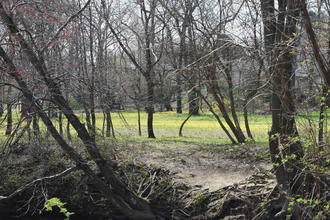Lesser Celandine (Ranunculus ficaria L.)
Also known as fig buttercup; also classified as Ficaria verna.
↑Summary
A perennial spring ephemeral flower Native to Europe and Western Asia, introduced in North America where it has become an ecologically-damaging invasive plant. Uncommon and scattered in many areas, but has become a dominant plant in parts of the mid-Atlantic through Massachussets.
↑Range - Expand
| Legend | Color |
| Introduced or Not Present | |
| Introduced |
This tentative map is based on our own research. It may have limited data on Canada and/or Mexico, and there is some subjectivity in our assignment of plants as introduced vs. expanded. Read more in this blog post.
Although this plant occurs somewhere in each of these regions, it may only occur in a small part of some or all of them.
↑Habitat
In North America, lesser celandine is found both in wild areas and anthropogenic habitats. It is predominately found in floodplains and bottomlands, on sites that are temporarily inundated, but not persistently under standing water, during its growing season of late winter to early spring. In these conditions it often forms large monocultures and is a dominant component of the vegetation. It is occasional in mesic upland forests, where it is usually restricted to sites that are locally-poorly-drained but lack accumulation of thick litter.
It is also found in lawns and unmowed gardens, where it usually colonizes exposed or disturbed ground. It is able to survive in mowed lawns, especially in wet, partly-shaded areas.
Lesser celandine is largely indifferent to the lighting conditions of an overhead tree canopy, as most of its lifecycle is completed before trees leaf out. As such it can be found in full sun, under closed-canopy forests, and all lighting conditions in-between. However it is cannot survive in areas where either a tree canopy or dense shrub understory of evergreens block light from reaching the ground.
Humans have hugely increased the habitat for this plant by mowing riparian areas, and by removing coarse leaf litter, often creating massive monocultures of this plant.
↑Life Cycle
This species is a perennial, but has a narrow window of time in which it is active, and is dormant for most of the year.
Leaves sprout from bulbils (mini bulbs) in late winter or early spring. Growth is rapid and the plant flowers fairly soon after sprouting. The foliage dies down in early summer.
Many plants do not produce fertile seed, and instead reproduce only vegetatively, by producing above-ground bulbils, which are distributed by water and also by humans. The bulbils root and grow into new plants.
Because of the narrow time-period in which this plant is active, it is highly sensitive to conditions during this time. It often thrives most in woodland areas where both trees and any competing herbaceous vegetation leaf out later, giving it ample light during its active period.
↑Control
Lesser celandine is one of the most difficult plants to control, but can be effectively controlled through a variety of strategies. The largest challenge is usually timing: this plant often emerges, completes its growing season, and goes dormant before most people begin managing property. The window for effective control is thus not only narrow, but earlier than most land managers are accustomed to.
Small populations can be controlled by digging up individual plants. However, due to the plant's small size and tiny bulbs, digging is often labor-intensive relative to the total amount of biomass being removed. Care must also be taken to remove and destroy all bulbs, which is difficult as mature plants often reproduce vegetatively, producing additional bulbs underground as well as above-ground, attached to leaf axils. Careless attempts at mechanical control can sometimes worsen infestations if they spread bulbs around and create soil disturbance, a condition in which this plant thrives.
Systemic factors are often key for reducing this species on sites where it is abundant. Coarse leaf litter has a slight inhibiting effect on this plant, reducing its flowering and production of seeds and bulbs. On sites where it is possible to solidly anchor coarse litter so it is not blown away by wind or swept away by water, deep enough litter can smother it entirely.
Competing vegetation, particularly that with evergreen basal foliage, can inhibit the growth of this plant. Some of the most competitive plants with it include cutleaf coneflower (Rudbeckia laciniata) and wildryes (Elymus sp.), with riverbank wildrye (Elymus riparius) and Virginia wildrye (Elymus virginicus) usually overlapping most with it in habitat. These species all emerge earlier and have taller basal foliage and aggressive root systems. Other species that are slightly less competitive but still compete with it include honewort (Cryptotaenia canadensis), great blue lobelia (Lobelia siphilitica), cardinal flower (Lobelia cardinalis), and golden ragwort (Packera aurea). Spring ephemerals such as dogtooth violet (Erythronium americanum), Virginia bluebells (Mertensia virginica), and narrow-leaved spring beauty (Claytonia virginica) also compete with it to a degree.
Herbicide can be used to control this plant. Typically glyphosate is used; because this plant tends to grow in moist bottomland areas and near wetlands and bodies of water, care must be taken to use formulations safe for use around aquatic life, and to apply a minimum amount required to kill the plants, and to do so on a dry day with no chance of rain so as to minimize harm to aquatic life. Glyphosate is non-selective and will also kill most non-target vegetation, so it is not suitable when this plant is growing in with native plants. When this plant is growing in with monocots (such as grasses, sedges, or rushes) but not any native broadleaf plants, selective herbicides such as triclopyr, 2,4-D, dicamba, or MCPA, can be used as they will kill this and other broadleaf plants without affecting monocots. Again, formulations designed for use it aquatic settings are recommended to minimize effects on aquatic life. If applying herbicide, it is important not to mow or cut the plant afterwards so that the herbicide is fully absorbed and transported into the roots.
Often, any control attempt, whether manual or herbicide, requires follow-up. A single year of control is rarely sufficient to remove this plant from a site due to dormant bulbs in the soil which can resprout when the more vigorous parts of the plant are eliminated.
Control also requires coordination within a watershed, as this plant tends to be transported downstream by water. It is usually most effective to start at the top of a watershed, control the most uphill/upstream populations first, and work downstream, as floods will transplant seeds and bulbs downstream, leading the plant to quickly recolonize downstream areas as long as upstream populations exist.
↑Uses
This plant was initially planted as a landscaping plant, where it was valued for its flowers. Planting it is now widely frowned upon, and is illegal in some states.
↑Links & External Resources
• Ranunculus ficaria (Lesser Celandine) | Illinois Wildflowers (About This Site)
• Ranunculus ficaria (Lesser Celandine) | USDA PLANTS Database (About This Site)
• Lesser Celandine | iNaturalist (About This Site)
• Ficaria verna | Biota of North America Project (BONAP) (About This Site)
• Ranunculus ficaria | NatureServe Explorer (About This Site)
• Ranunculus ficaria | Flora of North America (About This Site)
• Ranunculus ficaria L. | Plants of the World Online (POWO) (About This Site)





